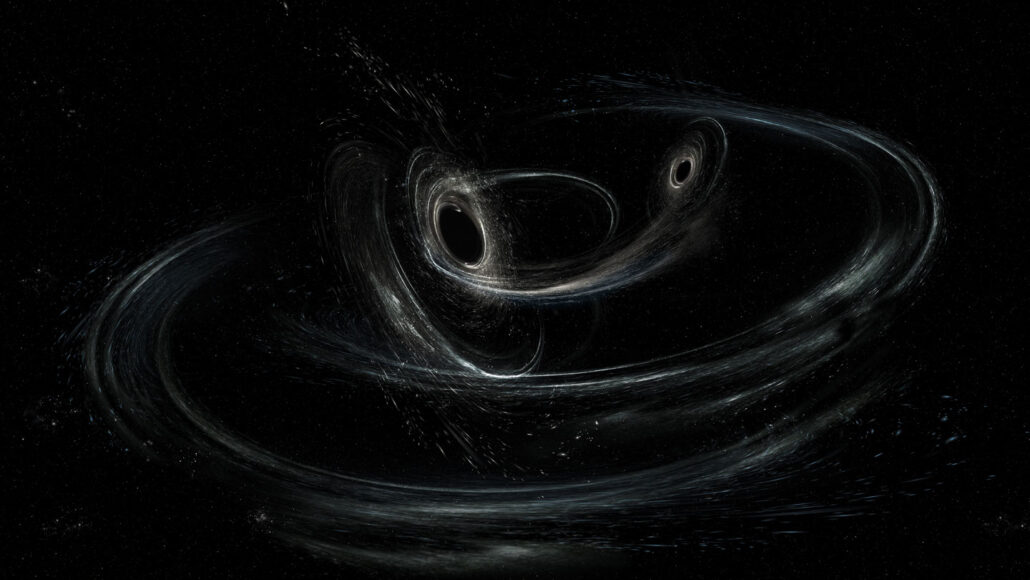Key Takeaways:
- Scientists observed a newborn black hole moving extremely fast, possibly due to a kick from gravitational waves during its formation from a binary black hole merger.
- This kick is similar to the recoil from a gun and can eject the black hole from its birthplace.
- The new black hole might have originated from a dense star cluster and the kick most likely freed it.
- Studying black hole kicks helps scientists understand the formation of massive black holes and the possibility of multiple mergers.
- This is the first observation of a large kick for a stellar-mass black hole using gravitational waves.
One black hole really knows how to kick back.
It was born when two others spiraled and smashed into each other. This new black hole was given a “kick” during formation that propelled it beyond its original location. It zoomed off at about 5 million kilometers (3.1 million miles) per hour — give or take a few million.
That is extremely fast. The universe’s fastest object is light. And it only traveled across space at a speed of 200 times that of this black hole.
Researchers shared their new analyses in a paper being published in Physical Review Letters
Cosmic kickback
Some of the universe’s most extreme objects are black holes. Each is so full of matter that even light cannot escape due to its gravitational pull. So, when two of these cosmic heavyweights collide, they pack a powerful punch. Indeed, the very fabric of spacetime itself could shake in the event of a black hole collision. We refer to those waves as gravitational waves. And if those waves tend to spread out from a black hole smashup in one direction, they will knock the newborn black hole the other way.

According to Vijay Varma, this recoil is comparable to a gun kicking back after firing a bullet. He works at the Max Planck Institute for Gravitational Physics as an astrophysicist. That is in Germany’s Potsdam.
Varma was part of the group that discovered the kickback of the black hole. On January 29, 2020, observatories recorded gravitational waves originating from black hole mergers. These observatories, which go by the names LIGO and Virgo, are situated in Italy and the United States.
The detected waves revealed details about how the two black holes merged. The plane in which the black holes orbited rotated as they passed each other. Precession is the term for that tilt (Pre-SEH-shun). It resembles the wobbling of a top during spinning. Such wobbly black holes are expected to get bigger kicks when they merge.
Whether the young black hole actually received such a boot was the question that Varma and his colleagues sought to answer. They thus dug further into the information.
The scientists compared their findings with models of black hole mergers that were predicted. They used a computer model to generate those forecasts. According to its simulations, there was a significant recoil. This implied that the young black hole had most likely been cast aside by the cosmos.
An unclear fate
This black-hole kick could have happened in a couple of different environments. A dense cluster of stars and black holes is one example. A globular cluster is the name given to such a group of stars. The kicked black hole most likely broke free from the cluster if it was born there. There’s only about a 0.5 percent chance it stayed within its home, the team calculated.
However, there’s a chance that the black hole merger took place in a different kind of dense environment. We refer to it as a nuclear star cluster. The kicked black hole then had an 8 percent probability of surviving.
The black hole’s great escape could have big implications. Why? Scientists want to know if black holes that partner up and merge in crowded clusters could partner up again. It’s possible that black holes could merge more than once. If they do, it could contribute to the understanding of the origin of some surprisingly massive black holes. However, multiple mergers would be less likely if merged black holes regularly burst out of their parent bodies.
According to Varma, “Kicks are very important in understanding the formation of heavy stellar-mass black holes.” In the new study, the merging black holes are known as stellar-mass black holes. When dying stars burst and collapse, they are born. Additionally, they differ from what are known as supermassive black holes. Galaxies are ruled by those much larger black holes.
Scientists have previously observed indications of gravitational waves providing powerful kicks to these supermassive creatures. However, that proof was presented as light, not gravitational waves. According to Manuela Campanelli, “gravitational waves are cleaner and easier to interpret, in a way.” The new study did not involve this astrophysicist. She is employed at New York’s Rochester Institute of Technology.
A small amount of evidence of stellar-mass black holes receiving kicks had been provided by Virgo and LIGO. However, the new study is the first to demonstrate a large kick to such a black hole.
That large kick is expected, according to Campanelli. It was anticipated by her and her colleagues that kicks with such force would occur. She is still happy to see the new study, though. “It’s always exciting when someone can measure from observations what you predicted from calculations.”


